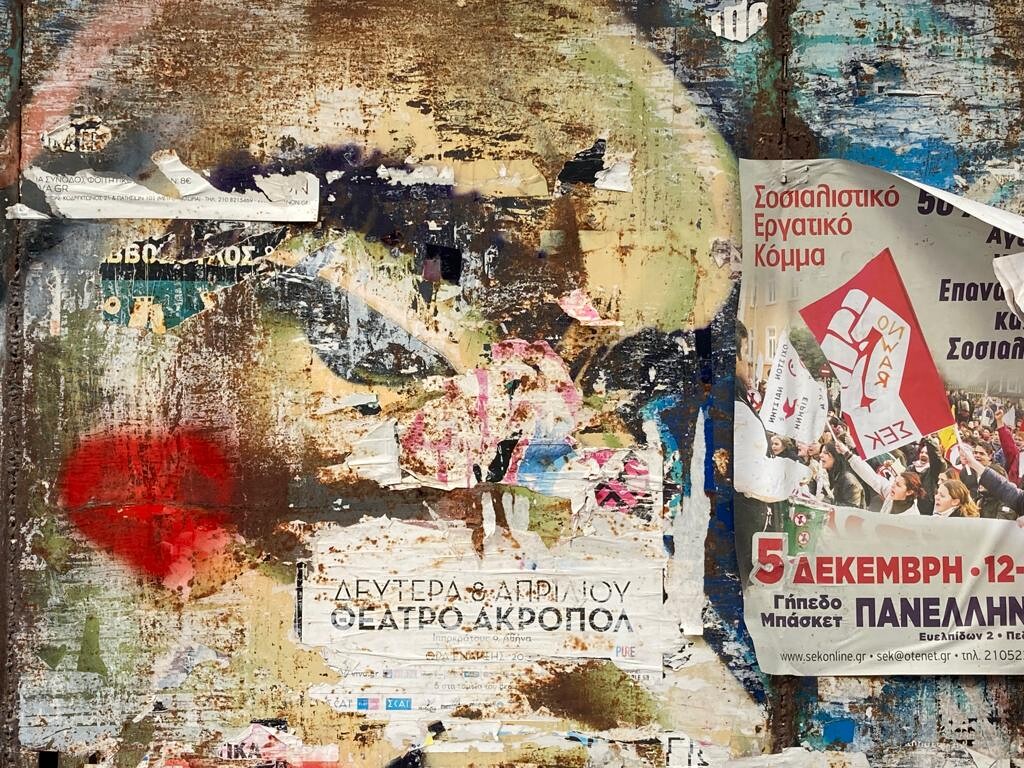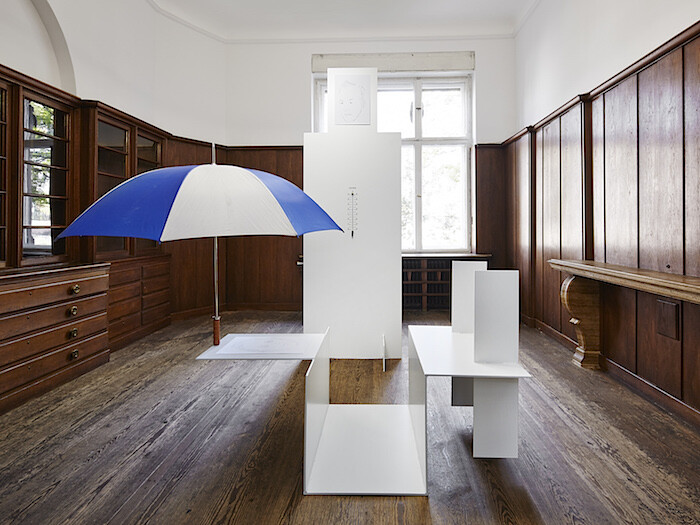Categories
Subjects
Authors
Artists
Venues
Locations
Calendar
Filter
Done
May 1, 2024 – Feature
Ben Rivers’s Collected Stories
Maria Dimitrova

This volume announces itself simply enough. “I am here to talk to you today about the work of Ben Rivers,” begins its opening chapter, which is by Daisy Hildyard. Hildyard’s piece offers a kind of inventory of the component parts of the celebrated British filmmaker: his name “comes from a Hebrew word meaning ‘son of’ and the geographical term, as in Ben Nevis, comes from a Gaelic word for mountain peak, or cone, which derives in turn from a word meaning ‘projection’.” His last name, as Hildyard points out, requires no explanation.
Hildyard’s essay is titled “The figure on the wall,” after Henry James’s short story “The Figure in the Carpet” (1896), about a journalist becoming obsessed with the hidden meaning embedded in the work of a novelist, the way a Persian rug features a repeated pattern. It’s a subtle introduction to the inherent premise of this volume, featuring fourteen writers responding to a different film by Ben Rivers, with no obligation to describe, discuss, or even mention the work in question. Far from being exercises in ekphrasis, many of these stories depict self-contained worlds—from a fairy tale queen giving birth to a beastlike son in Marina Warner’s “Blindsight” to …
March 2, 2022 – Feature
Zach Blas’s “Unknown Ideals”
Kevin Brazil

Unknown Ideals collects a range of texts written by the artist and educator Zach Blas since 2008: essays, a screenplay, poems, and the hallucinatory monologue of a mannequin getting fucked by a suction gun. These writings, and a selection of installation shots and stills from the exhibited works which prompted them, are interspersed with critical responses by theorists and art historians such as Alexander R. Galloway and Pamela M. Lee, as well as an interview conducted with curator Övül Ö. Durmuşoğlu. The book is far from a collected works: writing is central to Blas’s practice, and he has published a long bibliography of academic writings on film, queer theory, and digital media. Yet beyond being a simple miscellany, it serves as an introduction to the distinctive imaginary world which has animated the artist’s work in film, digital media, installation, and sculpture.
The opening text, “Unknown Ideals,” offers a panorama of that world: California, the site of the contemporary “informatic means of production.” Blas’s California—perhaps like every California—is fantasy. A landscape, retro and futuristic at the same time, of Disneyland, meditation retreats, and Silicon Valley; inhabited by The Doors and Jack Dorsey, but dominated by Ayn Rand, whose 1943 novel The Fountainhead …
November 30, 2021 – Feature
Brad Haylock and Megan Patty (Eds.), Art Writing in Crisis
Orit Gat

It is easier to discount the importance of things than it is to advocate for them. One would expect a book titled Art Writing in Crisis to make an argument for criticism in “times like these”—an exhausting task in which writers are cornered into justifying their practice, which may end up equating art, culture, and discourse with what is now termed “essential work.” The crisis in the title isn’t the one I initially thought it was: it’s not art criticism that is in crisis, but the world. Instead of proposing criticism as a solution to upheaval, the writers in this book are reflecting on how we work in the midst of global chaos. The theme of their essays is not the place of art criticism now; there are no solutionist ideals about the role of art in society, or claims of how crucial art and criticism are, “now more than ever.” Instead, the 22 texts are largely personal in approach but community-oriented in scope, and appended by historical surveys on art publishing and writing, making a true argument for the value of art and criticism—not to save a society in crisis, but to grow the sense of collectivity that builds …
September 24, 2021 – Feature
Berlin Roundup
Emily McDermott

Since the beginning of last year many artists have turned inward—or at least towards their immediate surroundings. Last week, during Berlin Art Week and Gallery Weekend Berlin’s Discoveries edition, over 70 exhibitions (some long-delayed) opened in the city’s galleries, institutions, project spaces, and private collections, featuring both established and emerging artists. The themes addressed are wide-ranging, but one recurring motif is an introspection expressed in portraiture: not necessarily in the figurative sense, but in using the framework of an exhibition to present a close study of one’s own identity, of a place, of an environment.
Reflecting this idea most overtly is Alicja Kwade’s exhibition “In Abwesenheit (In Absence)” at Berlinische Galerie. Here, the artist moves away from her usual cosmic explorations of time in favor of a show that is most clearly read as a self-portrait. 314,000 sheets of pale purple paper are printed with her fully sequenced DNA, with the 0.1% of letters that differentiate her from others bolded. Many sheets line the room’s towering walls, while thousands more are encased in bronze archival boxes. Twenty-four speakers are arranged on a giant black steel ring suspended from the ceiling, projecting Kwade’s heartbeat as it rises and falls. Bronze molds …
September 20, 2016 – Feature
Berlin Roundup
Matthew Evans

Berlin affluence is an oxymoron that might describe something in the big gap between pilsner and champagne, or pork schnitzel and sous-vide. Events like Berlin Art Week and its commercial fair abc art berlin contemporary have been pushing the German capital onto the national and international buyers’ tour for nine years now. It remains an odd positioning, as Berlin isn’t an obviously digestible city for many collectors; it lacks their creature comforts: the ubiquity of restricted access and unaffordable prices with enough locals who can afford to keep them that way. And art fairs (not to be confused with life) are most successful—and most distracting—when the rich feel hungry and foot the bill for the entertainment. But it’s an important exercise to distinguish between wealth and security (not to be confused with fear). The former is an uncertain orgasm of contrasts, which has become aesthetic cliché, while the latter is more interesting and maybe even radical today. Without the pressure (and pleasure) of fast and fat capital in recent history, Berlin has profited from this advantage, and although events like abc might be experimenting to revise that, the city still remains at one remove, which is a privilege, because the …
May 13, 2016 – Feature
Art Fair Roundup: Berlin, Brussels, Cologne, New York
Stefan Kobel

When Claus Föttinger installed his Bar 60/99-16 (2016) in the booth of Düsseldorf’s Van Horn Gallery at Art Cologne, Rhinelanders did what they are said to do best and partied, using the installation as an actual bar. Yet what might have been expected to be the biggest celebration—the opening of the 50th Art Cologne, the oldest continuously running contemporary art fair—was a rather sober event. Everything was in place: after a long and painful downturn, some important international galleries have returned to the fair since Daniel Hug became director in 2008. Almost all of the predominant German protagonists have become regulars again since the death of Art Forum Berlin in 2010, and collectors from neighboring countries visit the fair, even some Britons and Americans. All this adds to the unrivaled (in Europe) density of private collectors and institutions in the Rhine region. Sales have always been solid—rarely spectacular—at Art Cologne, where the collectors are traditionally educated and savvy but not deep-pocketed.
But for a 50th jubilee one would have expected more. The low-key atmosphere was only partly due the general sentiment of a world in crisis, and there are structural reasons why the fair felt uninspiring. One of its strengths has …